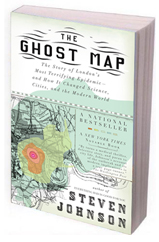I first heard of Steven Johnson’s 2006 book The Ghost Map from a George Will piece called “Survival of the Sudsiest.” The book’s full title is The Ghost Map: The Story of London’s Most Terrifying Epidemic — and How It Changed Science, Cities, and the Modern World. Will describes it as “a great scientific detective story about how a horrific cholera outbreak was traced to a particular neighborhood pump for drinking water.”
In the “The Books of Summer” (Liberty, July 2007), Bruce Ramsey also recommends it:
It tells the tale of the deadly outbreak of cholera in London in 1854, and how two men, a doctor and a preacher, proved how it was spread.… In parallel to the detective story is a revolting description of London in the early industrial age. The industrial revolution made London the earth’s largest city with the earth’s largest waste problem. Libertarians will note that market mechanisms did arise to handle this, though they were, in the author’s estimation, not so good. They will note that the first solution imposed by government made matters worse — but that the second one was better. The book also shows how the provision of sewers and a clean water supply ended cholera epidemics by the last quarter of the 19th century.
I’m finally getting around to reading The Ghost Map, and while it is compelling and enjoyable from the first page, it is also an excellent example of why it helps to have some economic literacy to be able to read popular history critically.
Both Johnson’s masterly prose and his questionable economics are evident from the first. Here’s his opening:
IT IS AUGUST 1854, AND LONDON IS A CITY OF SCAVENGERS. Just the names alone read now like some kind of exotic zoological catalogue: bone-pickers, rag-gatherers, pure-finders, dredgermen, mud-larks, sewer-hunters, dustmen, night-soil men, bunters, toshers, shoremen. These were the London underclasses, at least a hundred thousand strong. So immense were their numbers that had the scavengers broken off and formed their own city, it would have been the fifth-largest in all of England. But the diversity and precision of their routines were more remarkable than their sheer number. Early risers strolling along the Thames would see the toshers wading through the muck of low tide, dressed almost comically in flowing velveteen coats, their oversized pockets filled with stray bits of copper recovered from the water’s edge. The toshers walked with a lantern strapped to their chest to help them see in the predawn gloom, and carried an eight-foot-long pole that they used to test the ground in front of them, and to pull themselves out when they stumbled into a quagmire. The pole and the eerie glow of the lantern through the robes gave them the look of ragged wizards, scouring the foul river’s edge for magic coins. Beside them fluttered the mud-larks, often children, dressed in tatters and content to scavenge all the waste that the toshers rejected as below their standards: lumps of coal, old wood, scraps of rope.
Above the river, in the streets of the city, the pure-finders eked out a living by collecting dog shit (colloquially called “pure”) while the bone-pickers foraged for carcasses of any stripe. Below ground, in the cramped but growing network of tunnels beneath London’s streets, the sewer-hunters slogged through the flowing waste of the metropolis. Every few months, an unusually dense pocket of methane gas would be ignited by one of their kerosene lamps and the hapless soul would be incinerated twenty feet below ground, in a river of raw sewage.
The scavengers, in other words, lived in a world of excrement and death.
And here’s his assessment of why we don’t see scavengers today:
The homeless continue to haunt today’s postindustrial cities, but they rarely display the professional clarity of the bone-picker’s impromptu trade, for two primary reasons. First, minimum wages and government assistance are now substantial enough that it no longer makes economic sense to eke out a living as a scavenger. (Where wages remain depressed, scavenging remains a vital occupation; witness the pependadores of Mexico City.)
His second reason is “because most modern cities possess elaborate systems for managing the waste generated by their inhabitants.”
But notice what he implies in his first reason: minimum-wage laws have made the American working poor too well off to stoop to scavenging — in contrast to Mexico, where the laws presumably fail to do enough to raise the pependadores’ wages.
Anyone reading this blog already knows that the minimum wage is a price floor, and price floors can’t raise prices; they can only create a glut of the overpriced goods. Rather than increasing incomes, minimum-wage laws create a larger army of potential scavengers: the unemployed. The substantial government assistance that Johnson mentions may play a role in keeping the unemployed from turning to scavenging, as do today’s elaborate waste-management systems and the culture and legal mandates of recycling. But the most powerful cause — the one that has to come before all the others — gets no mention at all: greater wealth.
Mexico doesn’t have more scavengers because its laws are inadequately progressive. Mexico is poorer. And the reason it’s poorer is because of greater, not less, government interference. Historically, the United States has had more secure private-property rights and offered a more secure political and economic environment for investment. A more productive economy raises the wealth and well-being of even the poorest within the economy. Greater relative wealth means higher opportunity costs, which means that even the poorest Americans are less and less willing to do the most menial tasks even within the “legitimate” economy. This is why we so typically see people from less wealthy countries immigrating to the more wealthy countries to perform the most menial labor.
This influx of the foreign poor to do the jobs we won’t deign to do seems to many like a great social injustice. Rather than seeing it as the key to greater general well-being, the proponents of “social justice” see a violation of egalitarian ethics.
In a similar vein, Johnson writes,
We’re naturally inclined to consider these scavengers tragic figures, and to fulminate against a system that allowed so many thousands to eke out a living by foraging through human waste.
And “in many ways,” he adds, “this is the correct response.” I’ll return to this point.
But in addition to the “correct response” of fulmination, Johnson advocates “wonder and respect” for London’s 19th-century scavengers:
[W]ithout any central planner coordinating their actions, without any education at all, this itinerant underclass managed to conjure up an entire system for processing and sorting the waste generated by two million people.
(If his political reflexes weren’t already evident, he gives away his worldview in expressing wonder that spontaneously complex and efficient order can emerge among the scavengers “without any central planner coordinating their actions.”)
But the respect Johnson feels for the people does not extend to the “system that allowed so many thousands to eke out a living by foraging through human waste.”
Why not? Repulsion to scavenging is an understandable esthetic reflex, but is it a rational reaction to the dirtiest edges of the division of labor?
Harvard economist Edward Glaeser, who is far from libertarian, explains in The Triumph of the City that urban poverty — even and especially the shantytowns at the margins of cities and the unofficial jobs at the margins of the economy — can be a sign of the promise and success of a city: as poverty-reduction machines, market-rich cities attract more and more of the rural poor into the ranks of the urban poor. Over lifetimes and generations, the urban poor become the urban (and then often suburban) middle class.
In a free society with a healthy economy, we would see more scavengers, not fewer. As one generation raised itself from the refuse, and became less willing to take on the dirty work, another from elsewhere would step in to take its place. But they would not resemble the Dickensian muck-covered wretches of 19th-century London any more than modern laborers look like the factory workers of the Industrial Revolution. And we have the Industrial Revolution and those factory workers and owners and investors to thank for the greater prosperity that allows the developed world to look so different from the developing world. That was not achieved by labor unions or minimum-wage laws or a larger welfare state, by more regulations or social-justice campaigns. It was achieved despite these wealth-destroying developments.
I’m not saying that popular historians must embrace laissez-faire to make any contribution to our understanding of the past. But more often than not, they do not even show an awareness of the relevant issues or how the substantive arguments affect economic history.
The cause and effect they assume, and the social and political judgments that accompany them, are presented unquestioned. Even the most basic economic theory can give us the necessary tools to question them.



A very interesting and well thought out post. Thank you.
Thank you, Professor Raico. That means a lot to me.
There would still be opportunities for more scavengers to make a living, were it not for laws prohibiting it, such as laws requiting businesses to lock up their trash bins to prevent scavengers from getting to them .